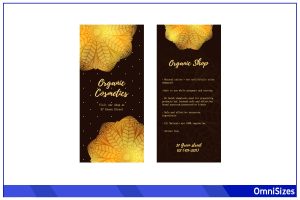In the world of paper and printing, size matters. Executive Paper size, often overlooked, plays a significant role in professional and personal documentation. Its unique dimensions set it apart from more common sizes like A4 or Letter.
Executive paper comes in multiple sizes, ranging from 7 × 10.5 to 7.5 × 10.5 inches. Sheets of paper measuring 7 × 10 inches may also be labeled as executive paper. This paper size is commonly used in business settings for memos, letters, and smaller reports, and offers a professional yet compact alternative to standard sizes.
This guide will explain executive paper dimensions in more detail, as well as describe its uses and how to print on this paper size.
Executive Paper Dimensions and Specifications
Executive paper is distinct in size and usage. The size is particularly favorable for printing on standard home and office printers since it requires no special adjustments.
Executive Paper Dimensions
Executive paper has multiple measurements, even though the differences between each size is marginal.
- Executive 1: 7 × 10.5 inches (17.78 × 26.67 cm)
- Executive 2: 7.25 × 10.5 inches (18.42 × 26.67 cm)
- Executive 3: 7.5 × 10.5 inches (19.05 × 26.67 cm)
In addition, you can also find 7 × 10-inch (17.78 × 25.4 cm) sheets of paper marketed as executive size. Considering legal paper size is 8.5 × 14 inches, the executive paper size offers a more tailored option for certain business needs. This size bridges the gap between standard letter-size paper (8.5 × 11 inches) and the smaller A5 size (5.8 × 8.3 inches or 14.8 × 21 cm).
Executive Paper Weight
The weight of executive paper is typically measured in pounds (lbs) or grams per square meter (gsm). Common weights for this paper size range from 20 lbs (75 gsm) to 70 lbs (105 gsm). The choice of weight depends on the intended use of the paper.
Lighter weights, like 20 lbs, are suitable for everyday office printing and internal documents. Heavier weights, such as 32 lbs or 70 lbs, offer a more substantial feel and are ideal for important documents, presentations, or when a higher-quality impression is desired.
Executive Paper Finishes
Executive Paper comes in various finishes, with the most common being matte, glossy, and textured.
- Matte Finish: This is the standard finish for most executive paper. It features a non-glare surface, making it ideal for documents that require readability. Matte paper absorbs ink well, resulting in sharp, clear text and images.
- Glossy Finish: Glossy executive paper has a shiny surface that enhances the colors and brightness of printed images. It’s often used for marketing materials, photos, and presentations where visual impact is key. However, it can be prone to fingerprints and smudges.
- Textured Finish: Textured paper, such as linen or laid, adds a tactile element to the document. This finish is often used for formal correspondence, business cards, and invitations. It provides an upscale, professional look and feel, suitable for high-end communications.
Executive Paper Uses and Applications
Executive paper’s unique size is particularly beneficial for certain applications where standard paper sizes are either too large or too small. The following sections describe this paper’s usage in more detail.
1. Business Correspondence
Executive paper is an excellent choice for printing, where a full-sized paper might appear too formal. The dimensions of executive paper make it perfect for brief reports, meeting notes, and inter-office memos.
2. Marketing and Promotional Material
Executive paper is also a popular choice for creating impactful marketing materials. Its size is suitable for compact brochures, product information sheets, and direct mail pieces. The unique dimensions can make promotional materials stand out among standard-sized counterparts.
3. Event Stationery
For event planning, executive paper offers an elegant option for invitations, programs, and menus. Its size is particularly appealing for formal events like corporate dinners, conferences, or seminars, where the paper’s dimensions add a touch of sophistication.
Formatting Your Printer for Executive Paper
With the correct settings and adjustments, printing on executive paper becomes a straightforward process anyone can do in no time.
1. Setting Up Your Printer
The first step in printing on Executive Paper is to set up your printer correctly. Most modern printers can easily handle this paper size, but it requires manual setup.
Begin by opening the printer’s settings on your computer. Look for the ‘Paper Size’ option and select ‘Executive’ from the list. If ‘Executive’ is not listed, you can manually enter the dimensions (any of the dimensions described above). Make sure the paper tray guides are adjusted to fit the size of the executive paper to prevent any misalignment or paper jams.
2. Adjusting Print Settings
After setting up the paper size, adjust the print settings to match the type of document you’re printing. For text documents, a standard print mode with normal quality is sufficient. If you’re printing images or graphics, opt for a higher-quality print setting.
3. Software Configuration
Before sending your document to the printer, make sure it’s formatted correctly in your word processor or design software. Set the page size to executive in the software’s page setup options. Double-check margins, as printing on a non-standard size might require adjusting them to achieve the desired layout.






